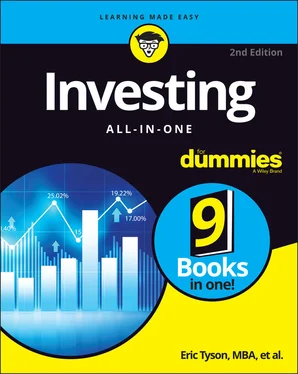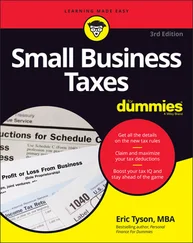Eric Tyson - Investing All-in-One For Dummies
Здесь есть возможность читать онлайн «Eric Tyson - Investing All-in-One For Dummies» — ознакомительный отрывок электронной книги совершенно бесплатно, а после прочтения отрывка купить полную версию. В некоторых случаях можно слушать аудио, скачать через торрент в формате fb2 и присутствует краткое содержание. Жанр: unrecognised, на английском языке. Описание произведения, (предисловие) а так же отзывы посетителей доступны на портале библиотеки ЛибКат.
- Название:Investing All-in-One For Dummies
- Автор:
- Жанр:
- Год:неизвестен
- ISBN:нет данных
- Рейтинг книги:3 / 5. Голосов: 1
-
Избранное:Добавить в избранное
- Отзывы:
-
Ваша оценка:
- 60
- 1
- 2
- 3
- 4
- 5
Investing All-in-One For Dummies: краткое содержание, описание и аннотация
Предлагаем к чтению аннотацию, описание, краткое содержание или предисловие (зависит от того, что написал сам автор книги «Investing All-in-One For Dummies»). Если вы не нашли необходимую информацию о книге — напишите в комментариях, мы постараемся отыскать её.
Investing All-in-One For Dummies
.
Dummies
Investing All-in-One For Dummies
Investing All-in-One For Dummies
Investing All-in-One For Dummies — читать онлайн ознакомительный отрывок
Ниже представлен текст книги, разбитый по страницам. Система сохранения места последней прочитанной страницы, позволяет с удобством читать онлайн бесплатно книгу «Investing All-in-One For Dummies», без необходимости каждый раз заново искать на чём Вы остановились. Поставьте закладку, и сможете в любой момент перейти на страницу, на которой закончили чтение.
Интервал:
Закладка:
Chapter 2
Investing for Long-Term Growth
IN THIS CHAPTER
 Balancing growth and value
Balancing growth and value
 Using strategies to select good growth stocks
Using strategies to select good growth stocks
What’s the number-one reason people invest in stocks? To grow their wealth (also referred to as capital appreciation ). Yes, some people invest for income (in the form of dividends), but that’s a different matter (see Chapter 3in Book 3). Investors seeking growth would rather see the money that could have been distributed as dividends be reinvested in the company so that (hopefully) a greater gain is achieved when the stock’s price rises or appreciates. People interested in growing their wealth see stocks as one of the convenient ways to do it. Growth stocks tend to be riskier than other categories of stocks, but they offer excellent long-term prospects for making the big bucks. Just ask Warren Buffett, Peter Lynch, and other successful, long-term investors.
Although someone like Buffett is not considered a growth investor, his long-term, value-oriented approach has been a successful growth strategy. If you’re the type of investor who has enough time to let somewhat risky stocks trend upward or who has enough money so that a loss won’t devastate you financially, then growth stocks are definitely for you. As they say, no guts, no glory. The challenge is to figure out which stocks make you richer quicker; this chapter gives you tips on how to do so.
 Short of starting your own business, stock investing is the best way to profit from a business venture. To make money in stocks consistently over the long haul, you must remember that you’re investing in a company; buying the stock is just a means for you to participate in the company’s success (or failure). Why does it matter that you think of stock investing as buying a company versus buying a stock? Invest in a stock only if you’re just as excited about it as you would be if you were the CEO in charge of running the company. If you’re the sole owner of the company, do you act differently than one of a legion of obscure stockholders? Of course you do. As the firm’s owner, you have a greater interest in the company. You have a strong desire to know how the enterprise is doing. As you invest in stocks, make believe that you’re the owner, and take an active interest in the company’s products, services, sales, earnings, and so on. This attitude and discipline can enhance your goals as a stock investor. This approach is especially important if your investment goal is growth.
Short of starting your own business, stock investing is the best way to profit from a business venture. To make money in stocks consistently over the long haul, you must remember that you’re investing in a company; buying the stock is just a means for you to participate in the company’s success (or failure). Why does it matter that you think of stock investing as buying a company versus buying a stock? Invest in a stock only if you’re just as excited about it as you would be if you were the CEO in charge of running the company. If you’re the sole owner of the company, do you act differently than one of a legion of obscure stockholders? Of course you do. As the firm’s owner, you have a greater interest in the company. You have a strong desire to know how the enterprise is doing. As you invest in stocks, make believe that you’re the owner, and take an active interest in the company’s products, services, sales, earnings, and so on. This attitude and discipline can enhance your goals as a stock investor. This approach is especially important if your investment goal is growth.
Becoming a Value-Oriented Growth Investor
A stock is considered a growth stock when it’s growing faster and at a higher rate than the overall stock market. Basically, a growth stock performs better than its peers in categories such as sales and earnings. Value stocks are stocks that are priced lower than the value of the company and its assets — you can identify a value stock by analyzing the company’s fundamentals and looking at key financial ratios, such as the price-to-earnings (P/E) ratio. (See Chapter 4in Book 3.) Growth stocks tend to have better prospects for growth in the immediate future (from one to four years), but value stocks tend to have less risk and steadier growth over a longer term.
Over the years, a debate has quietly raged in the financial community about growth versus value investing. Some people believe that growth and value are mutually exclusive. They maintain that large numbers of people buying stock with growth as the expectation tend to drive up the stock price relative to the company’s current value. Growth investors, for example, aren’t put off by P/E ratios of 30, 40, or higher. Value investors, meanwhile, are too nervous to buy stocks at those P/E ratio levels.
However, you can have both. A value-oriented approach to growth investing serves you best. Long-term growth stock investors spend time analyzing the company’s fundamentals to make sure that the company’s growth prospects lie on a solid foundation. But what if you have to choose between a growth stock and a value stock? Which do you choose? Seek value when you’re buying the stock and analyze the company’s prospects for growth. Growth includes, but is not limited to, the health and growth of the company’s specific industry, the economy at large, and the general political climate.
 The bottom line is that growth is much easier to achieve when you seek solid, value-oriented companies in growing industries. It’s also worth emphasizing that time, patience, and discipline are key factors in your success — especially in the tumultuous and uncertain stock investing environment of the current time (2020–2021).
The bottom line is that growth is much easier to achieve when you seek solid, value-oriented companies in growing industries. It’s also worth emphasizing that time, patience, and discipline are key factors in your success — especially in the tumultuous and uncertain stock investing environment of the current time (2020–2021).
Choosing Growth Stocks with a Few Handy Tips
Although the information in the previous section can help you shrink your stock choices from thousands of stocks to maybe a few dozen or a few hundred (depending on how well the general stock market is doing), the purpose of this section is to help you cull the so-so growth stocks to unearth the go-go ones. It’s time to dig deeper for the biggest potential winners. Keep in mind that you probably won’t find a stock to satisfy all the criteria presented here. Just make sure that your selection meets as many criteria as realistically possible. But hey, if you do find a stock that meets all the criteria cited, buy as much as you can!
To pick a winning stock, don’t just pick a stock and hope that it does well. In fact, your personal stock-picking research shouldn’t even begin with stocks; you should first look at the investing environment (politics, economics, demographics, and so on) and choose which industry will benefit. After you know which industry will prosper accordingly, then you can start to analyze and choose stock(s).
After you choose a stock, you should wait. Patience is more than just a virtue; patience is to investing what time is to a seed that’s planted in fertile soil. The legendary Jesse Livermore said that he didn’t make his stock market fortunes by trading stocks; his fortunes were made “in the waiting.” Why?
When you’re told to have patience and a long-term perspective, you’re waiting for a specific condition to occur: for the market to discover what you have! When you have a good stock in a good industry, it takes time for the market to discover it. When a stock has more buyers than sellers, it rises — it’s as simple as that. As time passes, more buyers find your stock. As the stock rises, it attracts more attention and, therefore, more buyers. The more time that passes, the better your stock looks to the investing public.
 When you’re choosing growth stocks, you should consider investing in a company only if it makes a profit and if you understand how it makes that profit and from where it generates sales. Part of your research means looking at the industry and sector and economic trends in general.
When you’re choosing growth stocks, you should consider investing in a company only if it makes a profit and if you understand how it makes that profit and from where it generates sales. Part of your research means looking at the industry and sector and economic trends in general.
Интервал:
Закладка:
Похожие книги на «Investing All-in-One For Dummies»
Представляем Вашему вниманию похожие книги на «Investing All-in-One For Dummies» списком для выбора. Мы отобрали схожую по названию и смыслу литературу в надежде предоставить читателям больше вариантов отыскать новые, интересные, ещё непрочитанные произведения.
Обсуждение, отзывы о книге «Investing All-in-One For Dummies» и просто собственные мнения читателей. Оставьте ваши комментарии, напишите, что Вы думаете о произведении, его смысле или главных героях. Укажите что конкретно понравилось, а что нет, и почему Вы так считаете.












